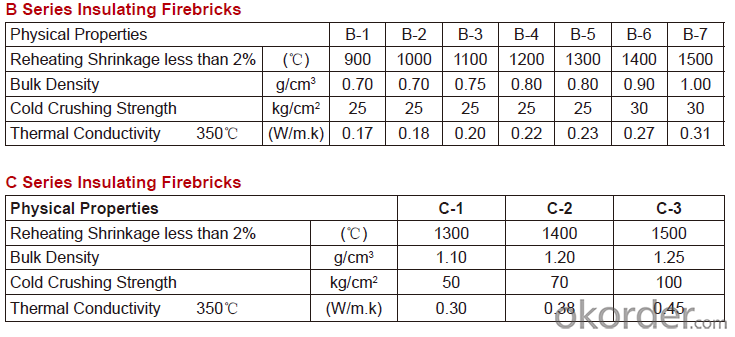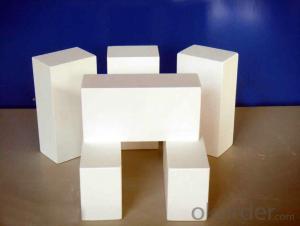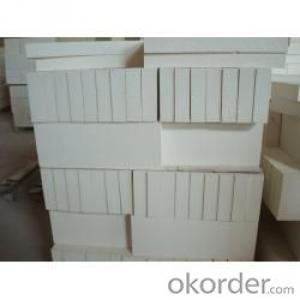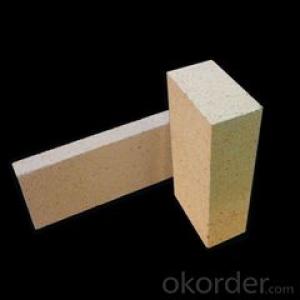Insulating Fire Brick - High Refractoriness Fire Clay Refractory Heat Insulation Bricks for Heating Furnace
- Loading Port:
- China main port
- Payment Terms:
- TT OR LC
- Min Order Qty:
- 1 m.t.
- Supply Capability:
- 1000 m.t./month
OKorder Service Pledge
OKorder Financial Service
You Might Also Like
Thermal Insulation Fire Clay Brick
Refractory brick is a block of refractory ceramic material used in lining furnaces, kilns, fireboxes, and fireplaces.
We provide high quality Refractory Fire Bricks that are used on wide range in the various industries like Cement, Glass and Steel. Refractory Fire Bricks are provided as per the quantity and specifications required by the customers. We provide an extensive range of Refractory Fire Bricks at reasonable prices that depend upon the quantity ordered.
Application
Insulating Fire Brick are used for the lining of converter, alternating current arc furnace, direct Current arc furnace and the ladle slag line, etc.
Company Advantage
(1)Long Insulating Fire Brick manufacture history: 25 years manufacturer
(2)Advanced equipment
(3)Diversification of production standards: ISO ANSI FEPA JIS ASTM
(4)Flexible payment: T/T L/C D/P D/A
(5)Professional marketing team and after-sale service
Insulating Fire Brick main feature:


Equipment
1 unit of Ceramic Abrasive (SG Abrasive) pilot production line
2 units of Compact grain Abrasive pilot production lines
1 unit of high-end coated abrasives (abrasive cloth) production line
2 units of Boron Carbide production lines
3 large flexible crushing and sieving lines for grit production lines
6 units of 5000KVA-10000KVA dumping type electric arc furnaces for Brown Fused Alumina fusion
Q1 What’s the transport method?
A1 FCL delivery goods with wooden pallet or wooden case by sea; If LCL delivery, must with wooden case; Sometimes need open top, flat rack or bulk cargo.
Q2 What’s the required payment term?
A2 Generally 30% TT as the prepayment, 70% TT before delivery. If need, 100% Irrevocable Letter of Credit or negotiation.
Q3 Which country are our products exported to?
A3 Apart from entire Chinese market, the US, Russia, Japan, Korea, Australia and some Southeast Asian Nations.


- Q: Can insulating fire bricks be used in metal smelting furnaces?
- Insulating fire bricks are indeed suitable for metal smelting furnaces. Specifically designed with low thermal conductivity, these bricks effectively retain heat and prevent heat loss from the furnace. This quality makes them perfect for maintaining high temperatures over long periods in metal smelting furnaces. Moreover, insulating fire bricks exhibit resistance to thermal shock, enabling them to endure the extreme conditions and sudden temperature fluctuations that occur during metal smelting processes. Additionally, their lightweight nature facilitates easy handling and installation within the furnace. In summary, insulating fire bricks are an excellent choice for enhancing energy efficiency and extending the lifespan of metal smelting furnaces.
- Q: Are insulating fire bricks resistant to moisture or water damage?
- Insulating fire bricks possess a general resistance to moisture and water damage. Their low porosity and high density prevent water absorption. Moreover, they are usually crafted from materials like alumina or silica, which inherently resist moisture. Nevertheless, it must be emphasized that no material is entirely impervious to water, and continuous exposure to moisture can gradually impact the insulating fire bricks. Thus, it is advisable to take essential measures, such as applying suitable sealants or coatings, to heighten their resistance to moisture or water damage in specific scenarios.
- Q: What is the price of thermal insulation brick for exterior wall?
- But also depends on how your drawings are made, so as to quote a specific price. There is also the price of each place is not the same, so the quotation will be different.
- Q: Are insulating fire bricks suitable for insulation in steam boilers?
- Yes, insulating fire bricks are suitable for insulation in steam boilers. They are designed to withstand high temperatures and provide excellent thermal insulation, making them ideal for use in steam boilers to minimize heat loss and improve energy efficiency.
- Q: Can insulating fire bricks be used to line industrial boilers?
- Yes, insulating fire bricks can be used to line industrial boilers. Insulating fire bricks are designed to withstand high temperatures and provide excellent insulation properties. They are commonly used in industrial applications, including lining furnaces, kilns, and boilers, to reduce heat loss and improve energy efficiency.
- Q: Can insulating fire bricks be used in high-temperature insulation for cryogenic applications?
- No, insulating fire bricks are not suitable for high-temperature insulation in cryogenic applications.
- Q: Can insulating fire bricks withstand thermal shock?
- Yes, insulating fire bricks are designed to withstand thermal shock due to their high temperature resistance and low thermal conductivity. They are made to endure rapid changes in temperature without cracking or breaking, making them suitable for various high-temperature applications.
- Q: Why does the water drop first and then rise when the boiler fires?
- Often in the operation of the boiler, the steam water mixture to the drum after intense evaporation of a large number of bubbles in the water side, the water volume expansion. By actual water level drum water level indicator is higher than the water level
- Q: Are insulating fire bricks resistant to carbon monoxide?
- Yes, insulating fire bricks are resistant to carbon monoxide. These bricks are specifically designed to withstand high temperatures and are commonly used in applications where exposure to intense heat and chemicals, such as carbon monoxide, is expected. The insulating properties of these bricks make them highly resistant to heat transfer, allowing them to maintain their structural integrity in the presence of carbon monoxide and other combustion gases. This resistance to carbon monoxide makes insulating fire bricks an ideal choice for applications such as furnaces, kilns, and other high-temperature environments where the risk of carbon monoxide exposure is present.
- Q: Can insulating fire bricks be used in the construction of lime production linings?
- Yes, insulating fire bricks can be used in the construction of lime production linings. These bricks are designed to withstand high temperatures and provide insulation, making them suitable for lining furnaces and kilns used in lime production. They can help maintain the desired temperature, conserve energy, and improve the efficiency of the lime production process.
Send your message to us
Insulating Fire Brick - High Refractoriness Fire Clay Refractory Heat Insulation Bricks for Heating Furnace
- Loading Port:
- China main port
- Payment Terms:
- TT OR LC
- Min Order Qty:
- 1 m.t.
- Supply Capability:
- 1000 m.t./month
OKorder Service Pledge
OKorder Financial Service
Similar products
Hot products
Hot Searches
Related keywords
































